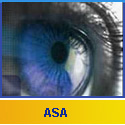In addition to LASIK, we offer ASA (Advanced Surface Ablation), a refractive procedure that can correct myopia, hyperopia, and astigmatism. We also offer treatment for cataracts and glaucoma to patients in Carlsbad and all over San Diego County.
ASA
 ASA, or Advanced Surface Ablation, is an outpatient refractive procedure that is used to correct nearsightedness (myopia), farsightedness (hyperopia), and astigmatism. Before ASA begins, you will be given eye drops for your procedure. During ASA at our Carlsbad office, the top layer of the cornea, called the epithelium, is removed to expose the stroma. Then a computer-controlled excimer laser reshapes the cornea. You can choose to have ASA performed on one eye at a time or both together. The entire ASA procedure takes about 15 minutes.
ASA, or Advanced Surface Ablation, is an outpatient refractive procedure that is used to correct nearsightedness (myopia), farsightedness (hyperopia), and astigmatism. Before ASA begins, you will be given eye drops for your procedure. During ASA at our Carlsbad office, the top layer of the cornea, called the epithelium, is removed to expose the stroma. Then a computer-controlled excimer laser reshapes the cornea. You can choose to have ASA performed on one eye at a time or both together. The entire ASA procedure takes about 15 minutes.
After ASA, you will wear special contact lenses to reduce discomfort. You may also use eye drops after ASA.
Patients usually experience some mild discomfort for about four days after ASA. Risks associated with ASA are similar to those with LASIK; however, ASA is generally considered safer than LASIK. If you are considering ASA, come in for a consultation at our Carlsbad office (located in North San Diego County).
Cataracts
Cataracts are the most common – and the most treatable – cause of impaired vision. Cataracts cloud the clear covering of the eye, or lens, causing vision to become blurry. Cataracts can also be responsible for glare, halos around lights at night, loss of depth perception, and difficulty reading or driving. Cataracts can affect one eye or both eyes and, if left untreated, can cause blindness. If you live in San Diego County and think that you may be suffering from cataracts, contact our Carlsbad office so we can begin the appropriate treatment.
What Causes Cataracts?
The cause of cataracts is unknown; however, there are certain risk factors related to cataracts, including:
- Age: Cataracts are part of the normal aging process. Most Americans over the age of 60 suffer from cataracts.
- Medical conditions: Diabetes, glaucoma, and metabolic abnormalities can all lead to cataracts.
- Injury to the eye: A traumatic blow to the eye, intense heat or cold, and other injuries can cause cataracts to form.
- Ultraviolet radiation: Long-term exposure to the sun can accelerate the development of cataracts.
- Oral steroids and other medications: Oral steroids and various medications have been linked to cataracts.
- Smoking: Studies have shown that smokers are twice as likely to develop cataracts than nonsmokers, and that quitting can reduce the risk for developing cataracts.
Early detection of cataracts is crucial to successful treatment. If you live in San Diego County and these risk factors apply to you, contact our Carlsbad office to schedule a consultation with one of our doctors.
How Are Cataracts Treated?
One way to treat cataracts is to use a stronger eyeglass prescription; however, cataracts can be removed surgically when they begin to interfere with your normal activities and glasses no longer work well for you. Here at our Carlsbad office, we offer surgical cataracts treatments for patients throughout San Diego County. The goal of cataract surgery covered by medical insurance is clearer vision while looking through a new pair of bifocal lenses. If your goal is to avoid glasses for near and distance vision, you may be a candidate for a Deluxe IOL.
The most common surgical technique to remove cataracts is phacoemulsification or “phaco.” During phaco, a small incision is made at the edge of the cornea. Next, a small ultrasonic probe is used to break up the cloudy lens. The tiny fragments are then gently suctioned and an intraocular lens (IOL) is implanted. No stitches are required for phaco, so there is less discomfort and faster recovery of vision than with other surgical techniques.
Another less common surgical option for cataracts is extracapsular cataract extraction (ECCE). This technique is used to remove cataracts that are too difficult to break up using phaco. This procedure requires a larger incision and stitches, so recovery time is longer.
If you live in San Diego County and want to learn more about the treatment options for cataracts, contact our Carlsbad office today.
Glaucoma
Glaucoma is a common eye disease that is caused by excessive pressure on or damage to the optic nerve. According to the Glaucoma Research Foundation, it is estimated that more than 3 million Americans have glaucoma, and only half of those know they have it! Glaucoma attacks peripheral vision first, so you can have 20/20 vision and still have glaucoma. If left untreated, glaucoma causes irreversible vision loss.
Glaucoma is the second leading cause of blindness in the U.S. and the first leading cause of preventable blindness (Glaucoma Research Foundation). There are several forms of glaucoma, the two main types being primary open-angle glaucoma (POAG) and angle-closure glaucoma.
POAG is the most common form of glaucoma. In POAG, drainage canals within the eyes remain open, but fluid still cannot drain as quickly as it is produced. This causes inner eye pressure to increase. In most cases, primary open-angle glaucoma has no symptoms but, if diagnosed early, responds well to treatment. Angle-closure glaucoma is considered a medical emergency, so it is imperative that you seek treatment immediately. With angle-closure glaucoma, pressure in the eye increases rapidly, causing damage to the optic nerve before the fluid can drain.
What are the Risk Factors of Glaucoma?
Like cataracts, glaucoma is a disease that is associated with the aging process. Additional risk factors of glaucoma include:
- Family history: If you have close relatives, such as a parent or sibling, that suffer from glaucoma, you may be at greater risk of having the disease.
- High intraocular pressure: People with intraocular pressure above 21 millimeters of mercury are at risk for glaucoma.
- Ethnicity: African-Americans are at high risk for glaucoma.
- Medications: Those who have used steroids or cortisone for an extended period of time are at a high risk for glaucoma.
- Injury: Eye trauma, such as sports-related injuries, can cause glaucoma years after the incident.
- Medical conditions: People with diabetes, high blood pressure, or migraine headaches are at a high risk for glaucoma.
If you live in San Diego County and have any of these risk factors of glaucoma, you should contact our Carlsbad office right away to schedule a comprehensive eye exam.
What are the Symptoms of Glaucoma?
People who have glaucoma often do not experience symptoms until they begin to lose their peripheral (side) vision, which is why glaucoma has become known as ‘the silent thief of sight.’ As glaucoma progresses, some of the following warning signs may be present:
- Loss of peripheral vision
- Headache or blurred vision
- Difficulty or inability to adjust vision in dark rooms
- Difficulty focusing on close work
- Halos or colored rings around lights
- Frequent need to change eyeglass prescriptions
Visual loss that results from glaucoma is permanent and irreversible. If you are experiencing any of these symptoms of glaucoma, contact us in Carlsbad right away to schedule a comprehensive eye exam.
How is Glaucoma Treated?
If you are suffering from primary open angle glaucoma, you may be given eye drops to decrease the pressure in your eyes. Because angle-closure glaucoma is an emergency and pressure needs to be reduced quickly, you may need to have the fluid drained intravenously. Another treatment option for glaucoma is laser surgery. With this technique, a laser is used to open the drainage canal to allow fluid to drain.
If these treatments are ineffective, traditional surgery is usually recommended. The most common surgery for glaucoma is trabeculectomy, in which a flap is created in the sclera to allow the fluid to drain.
The most important treatment for glaucoma is early detection and treatment. You should schedule regular eye care appointments to ensure you maintain optimal eye health. Don’t let this ‘silent thief of sight’ rob you of your eyesight. Contact us in Carlsbad, located in San Diego, today to schedule a comprehensive eye exam.
Eyelid Surgery
In addition to offering treatment for cataracts and glaucoma, Dr. Paul H. Chen performs eyelid surgery. Eyelid surgery can be performed for various reasons. It can improve vision that is impaired by sagging lids and it can correct various eyelid deformities or disorders, including abnormal eyelash growth, blepharospasm (the uncontrollable, forcible closure of the eyelids), entropion (a condition in which the eyelid is turned inward), ectropion (a condition in which the eyelid is turned outward), and ptosis (the drooping of the eyelids caused by weakness or paralysis of the upper eyelid muscles). Eyelid surgery can also remove growths, such as tumors.
If you want to learn more about ASA, cataracts, or glaucoma, contact North County Laser Eye Associates in Carlsbad today. We welcome patients from all over San Diego County.



